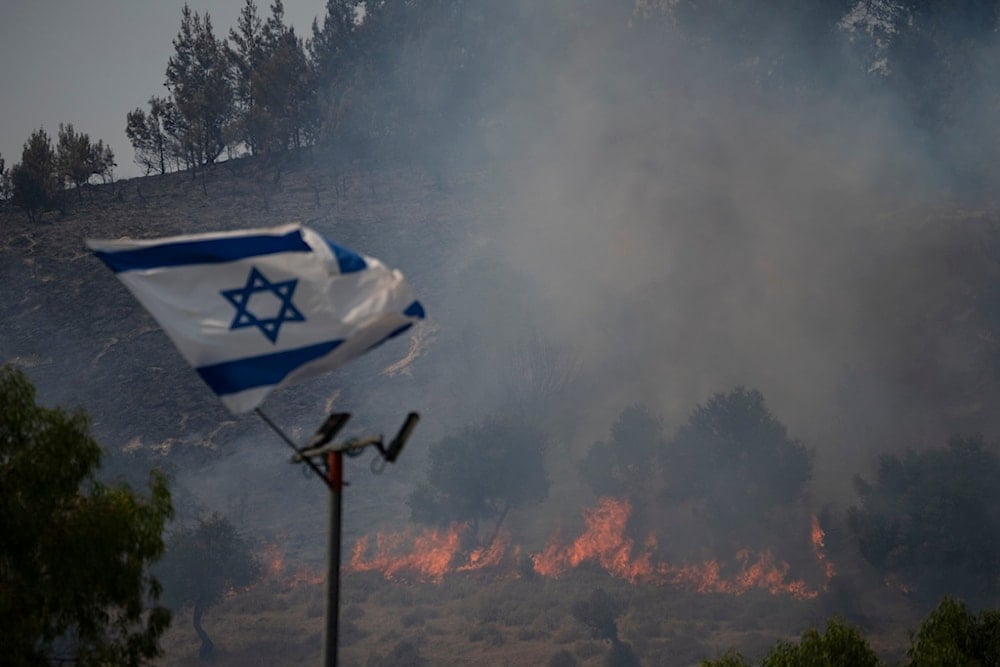'Israel' to see history's 'largest sustained rocket barrage' next war
A report published in The Economist magazine highlights the major changes since the July 2006 war on Lebanon.
-

An Israeli flag next to a fire burning in an area near the border with Lebanon, on Wednesday, June 12, 2024 (AP)
Hezbollah is much better prepared for an Israeli ground invasion of Lebanon compared to Ukraine's previous preparations against Russia in 2022, the British weekly magazine The Economist reported on Tuesday, citing an Israeli officer.
The officer pointed out that the locations that the Israeli military believed to be "well camouflaged" were repeatedly discovered and struck by Hezbollah, adding that the only reason the Israeli army has not suffered huge casualties in the North is that its forces "remain out of sight."
Tamir Hayman, former Israeli military intelligence chief, considered that if "Israel" wants to "create a change," it must "destroy all of Hezbollah's system."
"And right now I think it cannot be achieved," he indicated.
A former senior Mossad official stressed that the Israeli military is fatigued from Gaza operations and requires at least six months to prepare for another war.
According to the report, there have been four major changes since the July 2006 war on Lebanon, with the first being that the Lebanese Resistance group has acquired a wide range of "Iranian-designed kamikaze drones."
It noted that, despite many of the Israeli tanks and armored vehicles being equipped with active protection systems that can counter anti-tank missiles, these drones "target weaker points on the top of vehicles."
The second change is that Hezbollah has developed its ground forces, with its elite Radwan force, "intended to strike as far as 20km into Israel." Third comes the combat experience that Hezbollah fighters gained fighting alongside Russian air forces in Syria.
Additionally, the report highlighted that Hezbollah's firepower has "become more accurate," as the Lebanese group routinely uses drones to identify direct rocket targets and sends reconnaissance drones to identify targets for highly accurate attacks, according to the Israeli officer.
Hezbollah's air defenses have also improved, which might limit the Israeli military's freedom of maneuver, having seven of its large drones shot down by the Lebanese group since the beginning of the fighting.
In the same context, the report pointed to the "matter of scale," where the officer said that Israeli generals "talk optimistically" of a limited ground maneuver to capture a "security zone" to prevent Hezbollah from targeting Israeli settlements along the border with Lebanon.
He recalled that the Israeli military needed seven divisions to invade Lebanon in 1982 and used four divisions in the 2006 war. However, today, the Israeli military is preoccupied with the Gaza Strip and the West Bank, and at least one of its units dispatched to training bases in the North for drills, in settings simulating Lebanon, has already been sent back to fight in Gaza.
"I don’t see where they’re going to bring enough soldiers from," one Israeli reservist who took part in the exercises was quoted as saying.
Touching on the effects of a potential war, The Economist cited an unpublished report prepared by more than 100 experts and Israeli former officials convened by Reichman University and finalized in October.
The report warns that Hezbollah might launch 2,500 to 3,000 rockets daily, which is 25 times the rate of rocket fire in 2006, for three consecutive weeks, making it the largest continuous rocket barrage in history.
It pointed out that even if US destroyers offshore could destroy larger rockets, Israeli defensive systems would be overwhelmed in many areas, resulting in heavy casualties estimated at tens of thousands.
Read more: 'Israel' does not control the scope of war with Lebanon: Sheikh Qassem

 4 Min Read
4 Min Read








